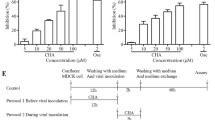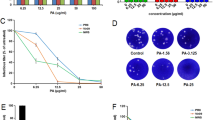Abstract
Scutellaria baicalensis Georgi, a Chinese herbal decoction, has been used for the treatment of the common cold, fever and influenza virus infections. In previous studies, we found that oral administration of baicalein resulted in the inhibition of influenza A virus replication in vivo, which was linked to baicalin in serum. However, the effective dose and underlying mechanisms of the efficacy of baicalin against influenza A virus have not been fully elucidated. In this study, the antiviral effects of baicalin in influenza-virus-infected MDCK cells and mice were examined. The neuraminidase inhibition assay was performed to investigate the mechanism of action of baicalin. In vitro results showed that baicalin exhibited a half-maximal effective concentration (EC50) of 43.3 μg/ml against the influenza A/FM1/1/47 (H1N1) virus and 104.9 μg/ml against the influenza A/Beijing/32/92 (H3N2) virus. When added to MDCK cell cultures after inoculation with influenza virus, baicalin demonstrated obvious antiviral activity that increased in a dose-dependent manner, indicating that baicalin affected virus budding. Baicalin had clear inhibitory effects against neuraminidases, with half-maximal inhibitory concentration (IC50) of 52.3 μg/ml against the influenza A/FM1/1/47 (H1N1) virus and 85.8 μg/ml against the influenza A/Beijing/32/92 (H3N2) virus. In vivo studies showed that an intravenous injection of baicalin effectively reduced the death rate, prolonged the mean day to death (MDD) and improved the lung parameters of mice infected with influenza A virus. These results demonstrate that baicalin acts as a neuraminidase inhibitor, with clear inhibitory activities that are effective against different strains of influenza A virus in both cell culture and a mouse model, and that baicalin has potential utility in the management of influenza virus infections.





Similar content being viewed by others
References
García-García J, Ramos C (2006) Influenza, an existing public health problem. Salud Publica Mex 48:244–267
Fraser C, Donnelly CA, Cauchemez S, Hanage WP et al (2009) Pandemic potential of a strain of influenza A (H1N1): early findings. Science 324:1557–1561
Neumann G, Chen H, Gao GF, Shu Y, Kawaoka Y (2010) H5N1 influenza viruses: outbreaks and biological properties. Cell Res 20:51–61
Droebner K, Pleschka S, Ludwig S, Planz O (2011) Antiviral activity of the MEK-inhibitor U0126 against pandemic H1N1v and highly pathogenic avian influenza virus in vitro and in vivo. Antiviral Res 92:195–203
Muratore G, Goracci L, Mercorelli B, Foeglein Á, Digard P, Cruciani G, Palù G, Loregian A (2012) Small molecule inhibitors of influenza A and B viruses that act by disrupting subunit interactions of the viral polymerase. Proc Natl Acad Sci 109:6247–6252
De Clercq E (2006) Antiviral agents active against influenza A viruses. Nat Rev Drug Discov 5:1015–1025
Deyde VM, Nguyen T, Bright RA et al (2009) Detection of molecular markers of antiviral resistance in influenza A (H5N1) viruses using a pyrosequencing method. Antimicrob Agents Chemother 53:1039–1047
Baranovich T, Saito R, Suzuki Y et al (2010) Emergence of H274Y oseltamivir-resistant A(H1N1) influenza viruses in Japan during the 2008–2009 season. J Clin Virol 47:23–28
Hsieh CF, Lo CW, Liu CH, Lin S, Yen HR, Lin TY, Horng JT (2012) Mechanism by which ma-xing-shi-gan-tang inhibits the entry of influenza virus. J Ethnopharmacol 143:57–67
Das K, Aramini JM, Ma LC, Krug RM, Arnold E (2010) Structures of influenza A proteins and insights into antiviral drug targets. Nat Struct Mol Biol 17:530–538
Spackman E (2008) A brief introduction to the avian influenza virus. Methods Mol Biol 436:1–6
Su B, Wurtzer S, Rameix-Welti MA et al (2009) Enhancement of the influenza A hemagglutinin (HA)-mediated cell-cell fusion and virus entry by the viral neuraminidase (NA). PLoS One 4:e8495
Chen L, Dou J, Su Z, Zhou H, Wang H, Zhou W, Guo Q, Zhou C (2011) Synergistic activity of baicalein with ribavirin against influenza A (H1N1) virus infections in cell culture and in mice. Antiviral Res 91:314–320
Grienke U, Schmidtke M, von Grafenstein S, Kirchmair J, Liedl KR, Rollinger JM (2012) Influenza neuraminidase: a druggable target for natural products. Nat Prod Rep 29:11–36
Harborne JB, Williams CA (2000) Advances in flavonoid research since 1992. Phytochemistry 55:481–504
Nijveldt RJ, van Nood E, van Hoorn DE, Boelens PG, van Norren K, van Leeuwen PA (2001) Flavonoids: a review of probable mechanisms of action and potential applications. Am J Clin Nutr 74:418–425
Wang X, Jia W, Zhao A, Wang X (2006) Anti-influenza agents from plants and traditional Chinese medicine. Phytother Res 20:335–341
Liu AL, Wang HD, Lee SM, Wang YT, Du GH (2008) Structure-activity relationship of flavonoids as influenza virus neuraminidase inhibitors and their in vitro anti-viral activities. Bioorg Med Chem 16:7141–7147
Song JM, Park KD, Lee KH et al (2007) Biological evaluation of anti-influenza viral activity of semi-synthetic catechin derivatives. Antiviral Res 76:178–185
Sithisarn P, Michaelis M, Schubert-Zsilavecz M, Cinatl J Jr (2013) Differential antiviral and anti-inflammatory mechanisms of the flavonoids biochanin A and baicalein in H5N1 influenza A virus-infected cells. Antiviral Res 97:41–48
Xu G, Dou J, Zhang L, Guo Q, Zhou C (2010) Inhibitory effects of baicalein on the influenza virus in vivo is determined by baicalin in the serum. Biol Pharm Bull 3:238–243
Yu C, Yan Y, Wu X, Zhang B, Wang W, Wu Q (2010) Anti-influenza virus effects of the aqueous extract from Mosla scabra. J Ethnopharmacol 127:280–285
Tian L, Wang Z, Wu H, Wang S et al (2011) Evaluation of the anti-neuraminidase activity of the traditional Chinese medicines and determination of the anti-influenza A virus effects of the neuraminidase inhibitory TCMs in vitro and in vivo. J Ethnopharmacol 137:534–542
Saha RK, Takahashi T, Kurebayashi Y et al (2010) Antiviral effect of strictinin on influenza virus replication. Antiviral Res 88:10–18
Dou J, Chen L, Xu G, Zhang L, Zhou H, Wang H, Su Z, Ke M, Guo Q, Zhou C (2011) Effects of baicalein on Sendai virus in vivo are linked to serum baicalin and its inhibition of hemagglutinin-neuraminidase. Arch Virol 156:793–801
Su Z, Dou J, Xu Z, Gou Q, Zhou C (2012) A novel inhibitory mechanism of baicalein on influenza A/FM1/1/47 (H1N1) virus: interference with midlate mRNA synthesis in cell culture. Chin J Nat Med 10:0415–0420
Yamanaka T, Bannai H, Nemoto M et al (2012) Efficacy of a single intravenous dose of the neuraminidase inhibitor peramivir in the treatment of equine influenza. Vet J 193:358–362
Bar-On Y, Glasner A, Meningher T et al (2013) Neuraminidase-mediated, NKp46-dependent immune-evasion mechanism of influenza viruses. Cell Rep 3:1044–1050
Barnard DL (2009) Animal models for the study of influenza pathogenesis and therapy. Antiviral Res 82:A110–A122
Acknowledgments
This research was financially supported by a project funded by the Priority Academic Program Development of Jiangsu Higher Education Institutions (PAPD), the Scientific and Technological Support & Social Development Plan of Jiangsu Province (BE2012743), the Fundamental Research Funds for the Central Universities (No. JKZY2013001, ZL2014SK0035), and Jiangsu Province Academic Scientific Research Industrialization Projects (JHB2012-6).
Author information
Authors and Affiliations
Corresponding author
Additional information
Y. Ding and J. Dou contributed equally to this work.
Rights and permissions
About this article
Cite this article
Ding, Y., Dou, J., Teng, Z. et al. Antiviral activity of baicalin against influenza A (H1N1/H3N2) virus in cell culture and in mice and its inhibition of neuraminidase. Arch Virol 159, 3269–3278 (2014). https://doi.org/10.1007/s00705-014-2192-2
Received:
Accepted:
Published:
Issue Date:
DOI: https://doi.org/10.1007/s00705-014-2192-2




